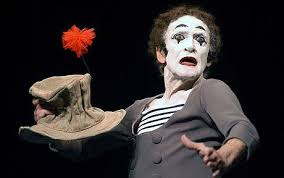
Mime is a type of dramatic performance not using words.
The term mime comes from the Greek word mimos meaning imitator. The ancient Greeks are thought to have first introduced mime as a style of performance. After the fall of the Roman Empire the ancient Romans adopted their own style of mime from the Greeks that exaggerated and emphasised physical traits and vulgar behaviour as a type of comedy. After mime was adopted into French culture it truly flourished and was developed by famous artists such as Jean- Gasoard Deburau, Etienne Decroux and Marcel Marcea. Mime evolved into three distinct styles among the Eastern, Italian and French performers, while all styles had different techniques and structures 20th century mime performers rejected the established styles and re formulated mime using ideas from each style.
Mime is one of the oldest of all forms of drama in Australia alone mime has been performed for over 60,000 years by the Aboriginals. When using mime the actors create meaning by using their movements and telling the story with their body. Aboriginal performers would imitate an animal with their body to show what their story was about.
Some people that were said to have made significant contributions to the world of mime include but are not limited to, John Weaver- said to be the father of English mime (1673-1760), Etienne Decroux- the father of modern mime, Jean- Gaspard Deburau adopted the white faced image of Pierrot and most notable Marcel Marcea- the world’s most famous mime and said to be the world’s greatest mime. (Other Famous Mime Artists,2014) Marcel Marceau survived the Nazi occupation and was known to move audiences without uttering a single word, he was said to be “the master of silence” (Marcel Marceau,2014). He was said to be one of the funniest mimes of his time. In 1959 he established his own school in Paris and a foundation to promote mime in the United States. A lot of changes were made to mime during the 20th century most of those changes were made by the French.
References
History of Mime. 2014. [online] Mimethegap.com. Available at: <http://www.mimethegap.com/historyofmime.html> [Accessed 17 Apr. 2014].
mime. 2014. [online] Dlibrary.acu.edu.au. Available at: <http://dlibrary.acu.edu.au/staffhome/siryan/academy/theatres/mime.htm> [Accessed 17 Apr. 2014].
Other Famous Mime Artists. 2014. [online] Members.tripod.com. Available at: <http://members.tripod.com/~kiko_mime/others.html> [Accessed 17 Apr. 2014].
The World of Mime Theatre * Library * History of Mime. 2014. [online] Mime.info. Available at: <http://www.mime.info/history-lust.html> [Accessed 17 Apr. 2014].